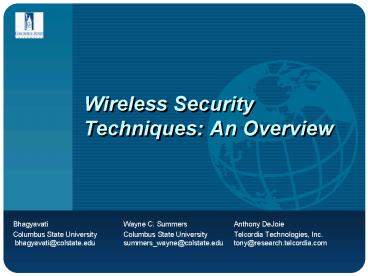Wireless Security Techniques: An Overview PowerPoint PPT Presentation
1 / 19
Title: Wireless Security Techniques: An Overview
1
Wireless Security Techniques An Overview
- Bhagyavati Wayne C. Summers Anthony DeJoie
- Columbus State University Columbus State
University Telcordia Technologies, Inc.
bhagyavati_at_colstate.edu summers_wayne_at_colstate.ed
u tony_at_research.telcordia.com
2
Agenda
1. Introduction
2. First Generation WLANs
3. Second Generation WLANs
4. Curricula Issues
5. Conclusions
3
Introduction
- Ubiquitous wireless networks
- Uncontrolled media / self-deploying network
- Wired vs. Wireless networks
- Early WLANs slow and not very secure
- Todays WLANs have more choices for enhanced
security, but are still flawed - Need to incorporate WLAN and WLAN security
concepts in our curriculum
4
WLANs
- Ad-Hoc Independent Basic Service Set (IBSS) -
computers talk directly to each other. - Basic Infrastructure Basic Service Set (BSS)
Network - all traffic passes through a wireless
access point. - Infrastructure Extended Service Set (ESS)
Network - traffic passes through multiple
wireless access points.
5
First Generation WLANs
- The IEEE 802.11 - specification allows for the
wireless transmission of raw data at indoor
distances from several dozen to several hundred
feet and outdoor distances of several to tens of
miles using Carrier Sense Multiple Access with
Collision Avoidance (CSMA/CA) - 802.11b - 11 Mbps using the 2.4 GHz
- 802.11a 54 Mbps using the 5 GHz band
- 802.11g 54 Mbps using 2.4 GHz
- 802.11n 540 Mbps (supports MIMO)
6
First Generation WLANs
- Minimal set of security features in 802.11b
standard - Service Set Identifier (SSID)
- Medium Access Control (MAC) address filters
- Wired Equivalent Privacy (WEP) encryption
- 64-bit RC4 data encryption (flawed) 128-bit
WEP also available - Does prevent casual eavesdropping (if turned
on) - Requires a sharing of the key between each mobile
device and the access point - No procedure for key management
7
First Generation WLANs
- Main Security Vulnerabilities
- Security settings are not enabled by default
- By default, access points broadcast SSID in clear
text - MAC address of valid client can be sniffed and
then spoofed - WEP is easily broken, only authenticates client
- Rogue access points are easy to deploy
- Man-in-the-middle attacks
- WLANs are easily crashed by DoS attacks
8
First Generation WLANs
- Security Controls
- Turn off the broadcast SSIDs
- Use automated MAC-based access control mechanisms
- Enable WEP encryption
- Lower power levels of access points / limit
transmission rates (11 / 5.5 Mbps)
9
Second Generation WLANs
- WPA (Wi-Fi Protected Access) interim encryption
standard FLAWED - 802.11i
- Temporal Key Integrity Protocol (TKIP)
- uses RC4
- generates new key every 10 Kb
- hashes Initialization Vector
- Message Integrity Check
- Advanced Encryption Standard (AES)
10
Second Generation WLANs
- 802.1X Framework for Authentication
- (EAP Extensible Authentication Prototcol)
- Transport Layer Security (EAP-TLS) used in
802.1X clients for Windows XP - Lightweight EAP (LEAP) CISCO product used in
Aironet products (dynamic WEP) - Protected EAP (PEAP) CISCO/Microsoft/RSA
doesnt require certificates supports dynamic
WEP - Tunneled Transport Layer Security (EAP-TTLS)
Funk Software/Certicom only requires server
certification
11
Second Generation WLANs
- VPN (Virtual Private Network)
- Wireless Gateway (simplifies roaming and provides
opportunity to implement QoS) - AirDefense WLAN Monitoring
- AirFortress provides for encryption at the MAC
layer, hiding data and network information
12
Policies, Training, Awareness
- Physical location of access points
- Logical location of access points (in DMZ)
- Ban rogue access points (monitor)
- Disable ad-hoc (peer-to-peer) mode on all clients
- Properly configure all devices
- Standardize on one vendor
- Perform frequent site surveys
- Monitor logs
- Keep patches up to date
13
Curricula Issues
- Where?
- Networking and Network Management Courses
- Introductory Security Courses
- Network Security Courses
- Cryptography Course (look at RC4/WPA/AES
encryption algorithms)
14
Curricula Issues
- What?
- Policy Standards for wireless networks
- Designing wireless networks
- Securing wireless networks
- look at encryption algorithms (RC4, WPA, AES)
- Look at standards (802.11i, 802.1X)
15
Curricula Issues
- How?
- Design Wireless Network Policy
- Work with University IT Department to help survey
security for campus wireless network - Installing and testing wireless networks
- War-driving (discuss ethical issues)
- Attack / Defend Exercises
16
Conclusions
- Ubiquitous wireless networks
- Home use
- Coffee shops, local communities
- IEEE 802.16 (WiMAX) - 75 Mb/sec, up to 30 miles
- Need to teach students how to secure them
17
Resources
- Wireless Security Blackpaper - http//arstechnica.
com/paedia/w/wireless/security-1.html - Wireless LAN Security FAQ - http//www.iss.net/wir
eless/WLAN_FAQ.php - The Unofficial 802.11 Security Web Page
-http//www.drizzle.com/aboba/IEEE/ - Wireless Network Security
- 802.11, Bluetooth and Handheld Devices -
http//csrc.nist.gov/publications/nistpubs/800-48/
NIST_SP_800-48.pdf
18
Questions?
19
(No Transcript)

